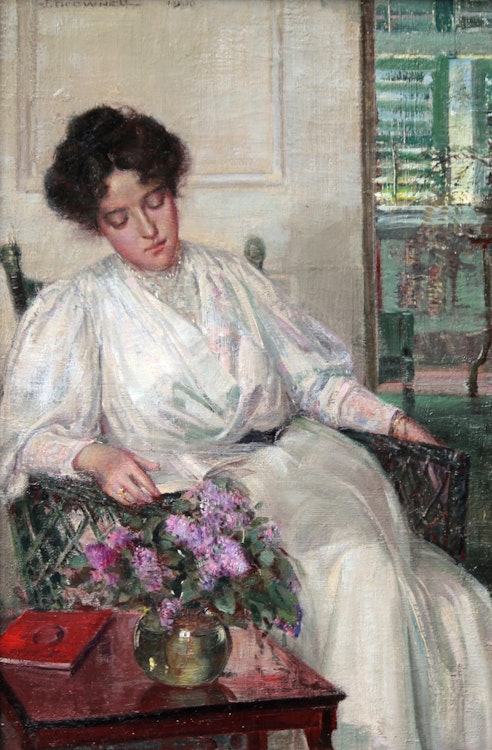Resting by Peleg Franklin Brownell

Franklin Brownell
Resting
oil on canvas
signed and dated 1906 upper left; signed with the artist’s address inscribed on the stretcher
18 x 12 ins ( 45.7 x 30.5 cms )
Auction Estimate: $7,000.00 - $9,000.00
Price Realized $12,980.00
Sale date: November 20th 2018
Collection of the artist
Private Collection, United States
Retrospective Exhibition, National Gallery of Canada, Ottawa, November 1 - 30, 1922, no. 12 as “Lent by Franklin Brownell, Esq., R.C.A., Ottawa”
Besides landscapes, he painted interior scenes in which light plays a role, and still life. Sometimes he combined subjects in dazzling displays of virtuosity, as in this canvas.
The painting shows a seated woman with a sweet face, resting. Beside her is a glass vase of flowers – lilacs - so we intuit that it is early summer. There is a book on the table. Behind her is an open door leading to another room in the house.
Light falls on the woman`s dress, letting us know there is a light source behind the painter.
This woman appears elsewhere in Brownell`s work. She seems to resemble a woman in the canvas “Arranging Flowers”, in “An Interesting Story” and perhaps in “A Home Lesson”.
It is tempting to think that she may have been a family relation, likely his wife, Louise Nickerson. Understandably, if this supposition is correct, this sweet-faced woman seems to have been his favorite model, along with a child, his daughter, Lois.
Brownell seems to have valued the painting specially and saved it for himself, only lending it to the large retrospective of his work at the National Gallery of Canada in 1922, the crowning achievement of his life.
We extend our thanks to Joan Murray, Canadian art historian, for contributing the preceding essay.
Share this item with your friends
Peleg Franklin Brownell
(1857 - 1946) RCA, OSA
Peleg Franklin Brownell was born in New Bedford, Massachusetts in July 1857, and studied at the Tufts School of the Museum of Fine Art in Boston, before going to Paris to study at the Academie Julian under Tony Robert-Fleury, Adolphe-William Bouguereau and Leon Bonnat. He remained in Paris until at least 1883, and then he returned to the United States, living first in New Bedford, and then in New York. He had met Canadian artist Willliam Brymner in Paris in 1881, before Brymner returned to Canada to become the principal of the Ottawa Art School. After both Brymner and his successor as the school’s principal, Charles Moss, moved elsewhere, Brownell was hired as the Ottawa Art School’s third principal in 1887, remaining in the position until the school’s closure in 1899. From 1900 until the school was revived in the early 1920s, he taught under the auspices of the Woman's Art Association of Ottawa. He finally retired from teaching in 1937, having taught many well-known and lesser well-known Canadian artists, including Frank Hennessey, Pegi Nicol MacLeod, and Henri Masson.
Once settled in Ottawa, Brownell rapidly established himself in Canadian art circles, becoming an associate of the Royal Canadian Academy of Arts in 1895, and a full member in 1895. He was also a member of the Ontario Society of Arts from 1899 to 1907, when he left that organization to help found the rival Canadian Art Club. His early work included Lamplight, an 1892 domestic scene which was exhibited at the 1893 Chicago World's Columbian Exposition, which was purchased by the RCA and presented to the National Gallery of Canada. His RCA diploma work, The Photographer, became part of the National Gallery’s collection in 1896. Brownell, although known as a painter of Ottawa and its environs, also painted in the West Indies, the US, the lower St. Lawrence, and the Gaspé. Although well-known for his landscapes, he produced portraits, flower studies, marine and genre scenes in oil, watercolour and pastel. He exhibited widely, in the annual exhibitions of several art associations, including the RCA, OSA, and the Art Association of Montreal; at more than a dozen exhibitions held at James Wilson & Co. Art Gallery in Ottawa from 1900 onwards; and in such international exhibitions as the 1893 Chicago Columbian Exposition, the 1900 Paris World's Fair, the Louisiana Purchase Exhibition, St Louis, 1904, and the British Empire Exhibition held at Wembley, England, in 1924-25. His work is to be found in most major Canadian art galleries, as well as in many private collections.
Brownell remains an elusive figure, as there is little evidence available in the form of diaries and correspondence to enable an art historian to learn more about his outlook or artistic philosophy. William Brymner described him as “a nice sort of cove” in 1881, and his firm friendships with many artists, collectors, and connoisseurs, most notably Eric Brown, director of the National Gallery of Canada from 1910 to 1939, attest to a likeable and well-respected man. On his death in March 1946, he was described as “a shy, retiring man” who was “one of the soundest artists in Canada”.
We extend our thanks to Jim Burant, Canadian Art Academic, for contributing this biography.

